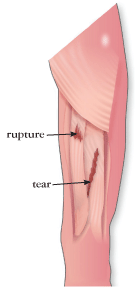 By Nancy Simpkins
By Nancy Simpkins
A dancer’s arabesque, a baseball player’s sprint for first base, and a football player’s place kick are all activities that depend on healthy hamstrings. The hamstrings are three muscles at the back of the thigh: the semitendinosus, semimembranosus, and biceps femoris. They start at the ischial tuberosity, (also called the sitz bone) at the back of the pelvis, and are connected to the lower leg by the hamstring tendons.
The term “hamstrung” acquired the meaning of “powerless” or “crippled” from the historical practice of cutting domestic servants’ hamstring tendons so they couldn’t escape. Now, hamstring injuries are most prevalent among athletes, particularly those who run, jump or kick.
The hamstrings help bend the knee and extend the hip, and they work in opposition to the quadriceps, the muscles on the front of the thigh. The quadriceps are normally stronger than the hamstrings, but if they become too much stronger, the resulting muscular imbalance puts the hamstrings at risk of injury. Tight hamstrings are also prone to injury.
What Causes Hamstring Injuries?
Hamstring strains can range from a partial tear of the muscle to a complete rupture. Symptoms range from tightness and pain in the back of the thigh to inability to walk or straighten the knee. There may be bruising in the back of the thigh, swelling, or muscle spasms. Sudden movement of the knee can cause the hamstring tendon to rupture. Symptoms include sudden pain at the back of the knee followed by swelling, and pain when bending the knee against resistance.
How Are Hamstring Injuries Treated?
Treatment of hamstring injuries usually starts with rest, ice, compression and elevation. Physical therapy may be recommended, and will include range of motion and strengthening exercises. Some doctors try to stimulate faster healing by injecting platelets of the patient’s own blood into the site of the injury, a technique called platelet rich plasma therapy (PRP). Severe hamstring injuries may require surgery.
To avoid hamstring injuries, it is important to warm up and stretch before exercise, and to do strengthening exercises as well. Athletes who have suffered one hamstring injury are at increased risk for another one. A physical therapist can teach you how to keep your hamstrings flexible and strong.